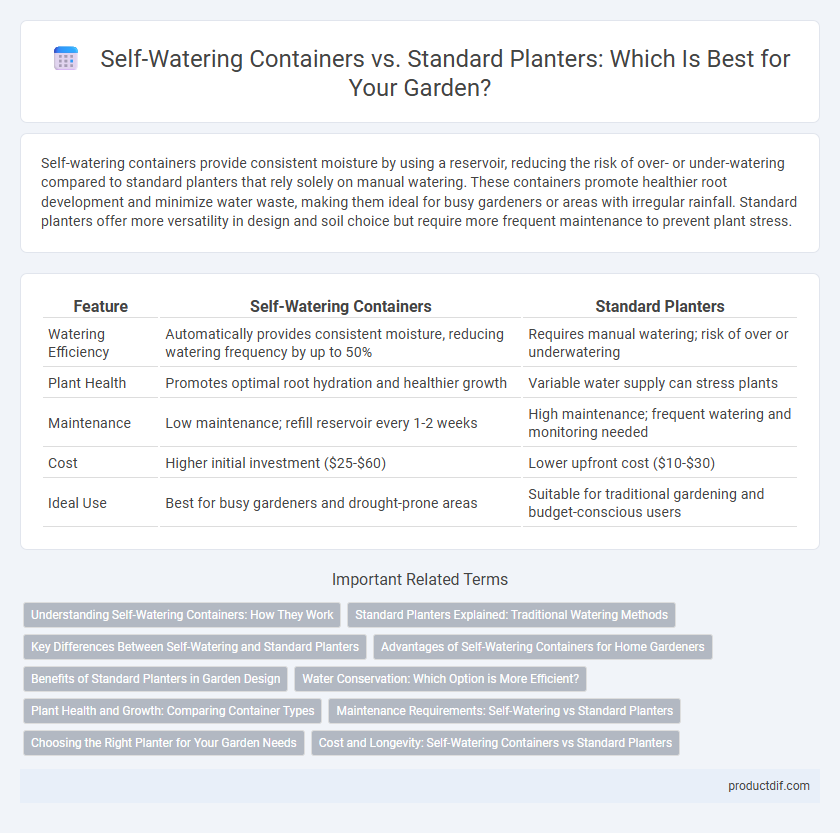Self-watering containers provide consistent moisture by using a reservoir, reducing the risk of over- or under-watering compared to standard planters that rely solely on manual watering. These containers promote healthier root development and minimize water waste, making them ideal for busy gardeners or areas with irregular rainfall. Standard planters offer more versatility in design and soil choice but require more frequent maintenance to prevent plant stress.
Table of Comparison
| Feature | Self-Watering Containers | Standard Planters |
|---|---|---|
| Watering Efficiency | Automatically provides consistent moisture, reducing watering frequency by up to 50% | Requires manual watering; risk of over or underwatering |
| Plant Health | Promotes optimal root hydration and healthier growth | Variable water supply can stress plants |
| Maintenance | Low maintenance; refill reservoir every 1-2 weeks | High maintenance; frequent watering and monitoring needed |
| Cost | Higher initial investment ($25-$60) | Lower upfront cost ($10-$30) |
| Ideal Use | Best for busy gardeners and drought-prone areas | Suitable for traditional gardening and budget-conscious users |
Understanding Self-Watering Containers: How They Work
Self-watering containers use a reservoir system that supplies water directly to plant roots through capillary action, reducing the frequency of manual watering. These containers maintain consistent soil moisture levels, promoting healthier plant growth and minimizing water wastage compared to standard planters. By allowing roots to absorb water as needed, self-watering containers optimize hydration and support efficient nutrient uptake.
Standard Planters Explained: Traditional Watering Methods
Standard planters rely on traditional watering methods that require manual watering, often through watering cans or garden hoses, demanding regular attention to moisture levels. These containers typically lack built-in reservoirs, making careful monitoring essential to prevent overwatering or drought stress in plants. Standard planters offer versatility in size and style, but their irrigation depends entirely on consistent gardener intervention.
Key Differences Between Self-Watering and Standard Planters
Self-watering containers feature a built-in reservoir that supplies consistent moisture to plants, reducing the frequency of watering compared to standard planters. Standard planters rely on manual watering and drainage through bottom holes, which can lead to uneven moisture levels and increased risk of under- or over-watering. The efficient water usage in self-watering containers promotes healthier root development and minimizes water waste, making them ideal for busy gardeners and drought-prone areas.
Advantages of Self-Watering Containers for Home Gardeners
Self-watering containers provide consistent moisture by supplying water directly to plant roots, reducing the risk of over- or under-watering common with standard planters. These containers conserve water through efficient irrigation, minimizing waste and ensuring plants receive the optimal amount for healthy growth. Home gardeners benefit from decreased maintenance and improved plant health, making self-watering containers ideal for busy or novice gardeners.
Benefits of Standard Planters in Garden Design
Standard planters offer unmatched versatility in garden design, allowing precise control over soil type and drainage that benefits a wide variety of plants. Their adaptability supports custom irrigation setups, making them ideal for gardeners aiming to tailor watering schedules and nutrient delivery. These planters also enhance aesthetic flexibility, with numerous shapes and materials available to complement diverse landscape themes.
Water Conservation: Which Option is More Efficient?
Self-watering containers utilize a reservoir system that reduces water evaporation and runoff, promoting efficient water use in garden supply management. Standard planters often require frequent watering, leading to increased water consumption and potential wastage. Studies indicate self-watering containers can save up to 50% more water compared to traditional planters, making them a superior choice for sustainable gardening.
Plant Health and Growth: Comparing Container Types
Self-watering containers maintain consistent soil moisture through built-in reservoirs, promoting healthier root systems and reducing water stress in plants. Standard planters require more frequent watering, which can lead to inconsistent moisture levels and potential root damage from over- or under-watering. The controlled hydration environment in self-watering containers often results in improved plant growth and higher yields compared to traditional planters.
Maintenance Requirements: Self-Watering vs Standard Planters
Self-watering containers reduce maintenance needs by providing consistent moisture through an internal reservoir, minimizing the frequency of watering and decreasing the risk of over or underwatering. Standard planters require more frequent watering and close monitoring to ensure soil moisture levels are adequate, which can increase time and effort spent on plant care. The self-watering system supports healthier root development and reduces maintenance stress for gardeners, making it ideal for those with limited time or experience.
Choosing the Right Planter for Your Garden Needs
Self-watering containers enhance moisture regulation by providing a consistent water supply, reducing the risk of overwatering or drought stress for plants. Standard planters offer versatility and simpler maintenance but require more frequent watering and careful attention to soil dryness. Selecting between self-watering containers and standard planters depends on your garden's watering needs, plant types, and the level of maintenance you can commit to.
Cost and Longevity: Self-Watering Containers vs Standard Planters
Self-watering containers typically have a higher upfront cost compared to standard planters due to their built-in reservoirs and complex design, but they offer superior water efficiency that can reduce long-term maintenance expenses. Standard planters are generally more affordable initially but may require frequent watering and replacement, especially in extreme weather conditions, impacting their overall longevity. Investing in high-quality self-watering containers can provide lasting durability with materials like UV-resistant plastic or ceramic, whereas standard planters vary widely in lifespan depending on material and care.
Self-watering containers vs Standard planters Infographic

 productdif.com
productdif.com